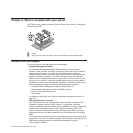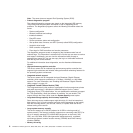Note: The server does not support Disk Operating System (DOS).
v Preboot diagnostics program
The preboot diagnostics programs are stored on the integrated USB memory.
They collect and analyze system information to aid in diagnosing server
problems. The diagnostics programs collect the following information about the
server:
– System configuration
– Network interfaces and settings
– Installed hardware
– EasyLED status
– Service processor status and configuration
– Vital product data, firmware, and UEFI (formerly called BIOS) configuration
– Hard disk drive health
– RAID controller configuration
– Event logs for RAID controllers and service processors
The diagnostics programs create a merged log that includes events from all
collected logs. The information is collected into a file that you can send to service
and support. Additionally, you can view the information locally through a
generated text report file. You can also copy the log to a removable media and
view the log from a Web browser.
For additional information about diagnostics, see the Hardware Maintenance
Manual.
v High-performance graphics controller
The server comes with an onboard high-performance graphics controller that
supports high resolutions and includes many performance-enhancing features for
the operating-system environment.
v Integrated network support
The server comes with an integrated dual-port Broadcom Gigabit Ethernet
controller, which supports connection to a 10 Mbps, 100 Mbps, or 1000 Mbps
network. For more information, see “Enabling the Broadcom Gigabit Ethernet
Utility program” on page 151.
v Integrated Trusted Platform Module (TPM)
This integrated security chip performs cryptographic functions and stores private
and public secure keys. It provides the hardware support for the Trusted
Computing Group (TCG) specification. You can download the software to support
the TCG specification, when the software is available. You can enable TPM
support through the Setup Utility under the System Security menu option.
v Large data-storage capacity and hot-swap capabilities
Some hot-swap server models support eight slim-high, 2.5-inch hot-swap hard
disk drives or four 3.5-inch hot-swap hard disk drives (depending on the model).
With the hot-swap feature, you can add, remove, or replace hard disk drives
without turning off the server.
v Large system-memory capacity
The server supports up to 48 GB (reduced to 24 GB in mirroring mode) of
system memory. The memory controller supports error correcting code (ECC) for
up to 12 industry-standard PC3-10600R-999 (single-rank or dual-rank), 800,
1067, and 1333 MHz, DDR3 (third-generation double-data-rate), registered,
synchronous dynamic random access memory (SDRAM) dual inline memory
modules (DIMMs).
v Memory mirroring
8 ThinkServer TD200 Types 3724, 3808, 3809, 3815, 3817, 3824, 3826, 3836: Installation and User Guide


















